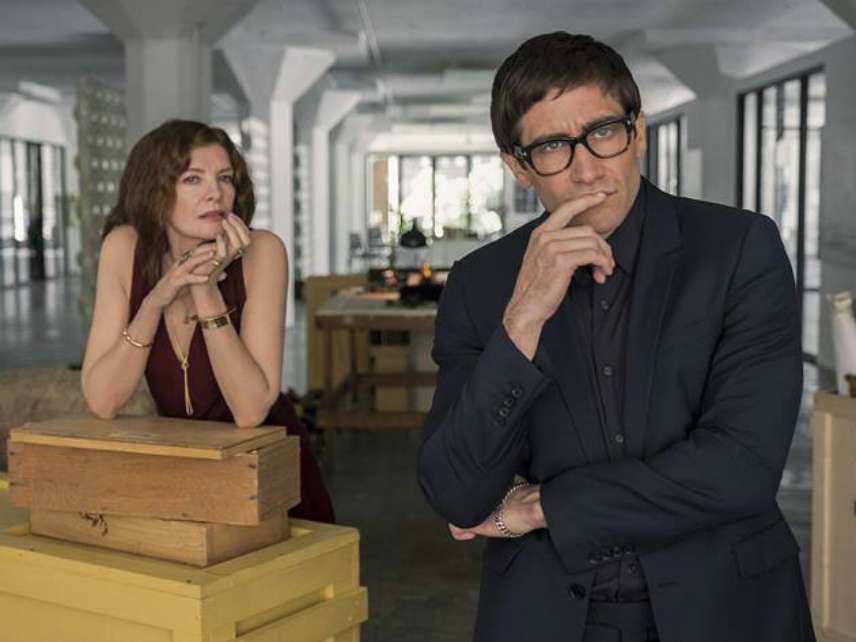Movie Review: Velvet Buzzsaw
Jake Gyllenhaal and the art of evil.

A number of people die for their art in Velvet Buzzsaw. Others manage to survive, but only after enduring onslaughts of art-biz babble like, "Our gallery has cutting-edge analytics to optimize deal-flow and global demand." The smartest person in this new Netflix movie might be a good-hearted office assistant named Coco (Natalia Dyer, of Stranger Things), who bails out of the LA art scene at the end and heads back home to the Midwest, happy, no doubt, to be alive.
Taking a blowtorch to the art world—its inane fads, its swanning critics—is nothing new: Tom Wolfe did it memorably with his 1975 takedown, The Painted Word. What writer-director Dan Gilroy has done differently here is to blend familiar (but still funny) mockery of the art scene with a really creepy supernatural horror story.
The dark shadow that hovers over Velvet Buzzsaw is a deceased "outsider" artist called Vetril Dease (just about everybody has a crazy name in this movie). Vetril's baleful presence, if it can be called that, will quickly become unignorable. First, though, we meet the cast of glib, self-absorbed characters. We do this by shadowing an influential art critic named Morf Vandewalt (Jake Gyllenhaal) as he makes his rounds of the galleries of Los Angeles and beyond in search of new talent to promote in his columns. Being a powerful cultural arbiter, Morf is constantly being pitched. ("This encompasses on a global scale," one art promoter tells him, talking up a client's work. "There's just such a sense of now and in-your-face, which speaks to pop and cinema and economics.") Morf comes upon a big chrome sphere sitting in a white-walled museum room and somebody tells him, "It's called 'Sphere.'" He encounters a bizarre automaton—a mechanical hobo—that tells him, in a grotesque robo-voice, "I can't save you." Just as well, maybe.
Morf is tight with an LA gallery owner named Rhodora Haze (Rene Russo, who's married to Gilroy and also costarred with Gyllenhaal in Nightcrawler, the first film her husband directed). Rhodora has an ambitious assistant named Josephina (a star turn by Zawe Ashton, of Nocturnal Animals) and a once-hot client—a painter named Piers (John Malkovich)—who has lost his creative momentum. Also on the scene is a charismatic younger artist called Damrish (Daveed Diggs, of Black-ish) and a museum curator named Gretchen (Toni Collette), who's ready to go private as an art advisor and rake in some real money.
Things start getting strange when Josephina finds the dead body of an old man on a high landing in her apartment building. This is—or was—Vetril Dease. Slipping into his unlocked apartment, Josephina finds that it's crammed, wall to wall, with a lifetime's worth of primitive but haunting artwork. (Dease is clearly modeled on the celebrated outsider pack rat Henry Darger.) Soon she learns that Dease had ordered all of his work destroyed after his death, to ensure that no one would profit from trading in it—a thought that apparently enraged him. But Josephina's boss Rhodora sets up a legal end run around Dease's final wish that will allow Josephina—and by extension Rhodora, too—to take over the man's legacy and use it to make them both very rich.
But as Morf learns in researching Dease, his murky backstory is filled with murder, torture and madness. And we soon see that his paintings are inhabited by a malign spirit—they burst into flames, they bleed, and generally make life very hard to go on living for anyone who tries to traffic in them. Gilroy creates skin-crawlingly eerie effects—figures that start stirring within the paintings, hands that reach out of their frames—and some wonderfully sinister set-piece scenes (there's a projector that turns itself on and can't be turned off, and a flickering light bulb that simply must be replaced right now) There's also a scene set in a museum that's so spectacularly bloody, and draws so many gawkers, that it's soon "spiking on Instagram," as one impressed observer notes.
I'm not sure if all of this adds up. Is the evil with which Dease infused his paintings capable of infecting art made by other hands? That seems to be the case. But how does that work? And what about the new questions it raises? By the time the hideous robo guy reappeared, though, I didn't much care anymore.
